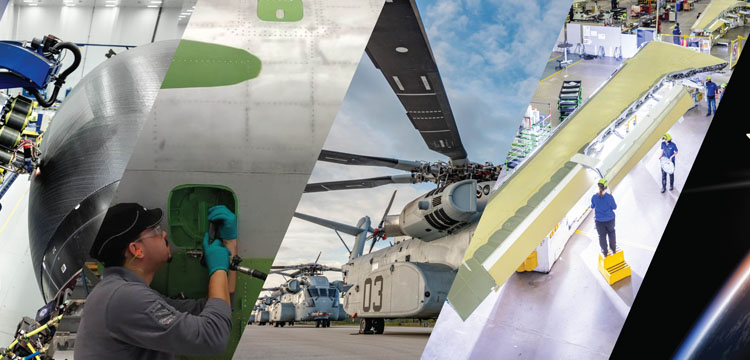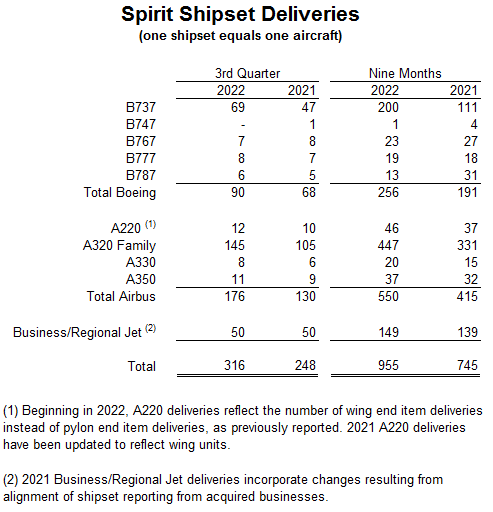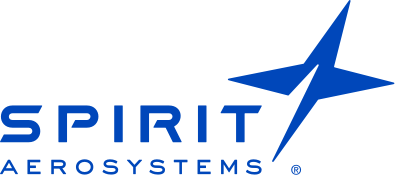

Spirit AeroSystems Reports Third Quarter 2022 Results
Third Quarter 2022
- Revenue of $1.3 billion, up 30% y/y
- Executing U.S. pension termination which will include negative EPS impacts in 2022 and 2023, with expected favorable after-tax cash impact in the range of $120 - $150 million in 2023
- EPS of $(1.22); Adjusted EPS* of $(0.15)
- Cash used in operations of $36 million; Free cash flow* usage of $73 million
- Launching cost optimization program to enhance profitability and cash flow in 2023
Wichita, Kan., November 3, 2022 - Spirit AeroSystems Holdings, Inc. (NYSE: SPR) (“Spirit” or the “Company”) reported third quarter and nine months 2022 financial results.

“While air traffic is recovering, we continue to see disruptions in our factories due to part shortages, increased levels of employee attrition and volatile schedules,” said Tom Gentile, President and Chief Executive Officer, Spirit AeroSystems.
“We continue to leverage our investments in productivity, including digitization and automation, as well as strengthening our workforce to stabilize production at the current rates and position ourselves for future rate increases. Given that our production rate is set at 31 aircraft per month on the 737 program now, and we will likely remain at that rate for much of 2023, we are initiating a focused effort to reduce structural costs to enhance our profitability and cash flow in 2023."
Revenue
Spirit’s revenue in the third quarter of 2022 was $1.3 billion, up 30 percent from the same period of 2021. This increase was primarily due to higher production deliveries on the Boeing 737 program as well as increased Aftermarket revenue, partially offset by lower production deliveries on the Boeing 747 program. Overall deliveries increased to 316 shipsets during the third quarter of 2022 compared to 248 shipsets in the same period of 2021. This includes Boeing 737 deliveries of 69 shipsets compared to 47 shipsets in the same period of the prior year.
Spirit’s backlog at the end of the third quarter of 2022 was approximately $36 billion, with work packages on all commercial platforms in the Airbus and Boeing backlog.
Earnings
Operating income for the third quarter of 2022 was $4.5 million, compared to operating loss of $156.6 million in the same period of 2021. This increase in operating income was primarily driven by higher production on the Boeing 737 program and lower forward loss charges, compared to the same period of the prior year. Third quarter 2022 earnings included net forward loss charges of $49.1 million and unfavorable cumulative catch-up adjustments of $4.9 million. The forward losses relate primarily to the Airbus A350, Boeing 787 and RB3070 programs. The Airbus A350 program forward loss reflects additional costs related to labor, freight and rework and the impact of part shortages. The forward loss on the Boeing 787 program was driven by increased supply chain and other costs. The RB3070 nacelle program forward loss was driven by increased engineering cost estimates. Excess capacity costs recorded during the third quarter of 2022 were $31.4 million. In comparison, during the third quarter of 2021, Spirit recorded $70.4 million of net forward loss charges, unfavorable cumulative catch-up adjustments of $2.8 million, and excess capacity costs of $57.1 million.
Other expense for the third quarter of 2022 was $42.1 million, compared to other income of $94.8 million in the same period of 2021. The increase in expense was primarily due to non-cash pre-tax charges of $72.6 million largely driven by an enhancement to benefits the Company is providing to certain U.S. employees in conjunction with the termination of the Pension Value Plan A (PVP A) in the third quarter of 2022, compared to a gain of $61 million in the third quarter of 2021 resulting from the closure of the defined benefit plans acquired as part of the Bombardier acquisition. In relation to the termination of the PVP A, additional non-cash settlement charges are expected in the fourth quarter of 2022 and the first quarter of 2023. The Company also expects to receive an after-tax cash reversion in 2023 resulting from the PVP A termination in the range of $120 million to $150 million.
Third quarter 2022 EPS was $(1.22), compared to $(1.09) in the same period of 2021. Third quarter 2022 adjusted EPS* was $(0.15), excluding the incremental deferred tax asset valuation allowance and the costs related to the pension termination. During the same period of 2021, adjusted EPS* was $(1.13), which excluded the incremental deferred tax asset valuation allowance and the curtailment gain. (Table 1)
Cash
Cash used in operations in the third quarter of 2022 was $36 million, compared to $211 million of cash provided by operations in the same quarter last year. The prior year balance reflects the receipt of a $228 million tax refund resulting from the CARES Act and $38 million received from the Aviation Manufacturing Jobs Protection Program. The current period cash used in operations included the quarterly cash repayment of $31 million related to the Boeing 737 advance received in 2019. Free cash flow* in the third quarter was a usage of $73 million, as compared to a free cash flow* of $174 million in the same period of 2021.
During the pandemic, the Company reduced its quarterly cash dividend to $0.01 per share in 2020. Due to the current challenging macroeconomic environment, the Board has decided to suspend the Company’s quarterly cash dividend beginning in the fourth quarter of 2022.
The cash balance at the end of the third quarter of 2022 was $671 million. (Table 2)

Segment Results
Commercial
Commercial segment revenue in the third quarter of 2022 increased 32 percent from the same period of the prior year to $1.0 billion, primarily due to increased production revenues on the Boeing 737, 777 and Airbus A320 programs, partially offset by lower production volumes on the Boeing 747 program. Operating margin for the third quarter of 2022 increased to 4 percent, compared to (9) percent during the same period of 2021. This improvement was primarily due to higher volumes on the Boeing 737 program and lower net forward losses and excess capacity costs in the current period. In the third quarter of 2022, the segment recorded $47.4 million of net forward losses and $6.9 million of unfavorable cumulative catch-up adjustments. Additionally, during the third quarter of 2022, the Commercial segment included excess capacity costs of $29.9 million. In comparison, during the third quarter of 2021, the segment recognized $61.5 million of net forward losses, $3.4 million of unfavorable cumulative catch-up adjustments and excess capacity costs of $54.8 million.
Defense & Space
Defense & Space segment revenue in the third quarter of 2022 increased 17 percent from the same period of the prior year to $161.7 million. This increase was primarily due to higher production revenue on the Boeing P-8 and Sikorsky CH-53K programs and higher activity on development programs, partially offset by lower KC-46 Tanker revenue in the current quarter. Operating margin for the third quarter of 2022 increased to 11 percent, compared to 6 percent during the same period of 2021, primarily due to increased classified program profit and lower forward loss charges than the same period in the prior year, partially offset by lower margin in the current year period on the Sikorsky CH-53K program due to increased costs. The segment recorded excess capacity costs of $1.5 million, net forward losses of $1.7 million and $2.0 million of favorable cumulative catch-up adjustments in the third quarter of 2022, compared to excess capacity costs of $2.3 million, net forward losses of $8.9 million and $0.6 million of favorable cumulative catch-up adjustments in the third quarter of 2021.
Aftermarket
Aftermarket segment revenue in the third quarter of 2022 increased 38 percent from the same period of 2021 to $80.3 million, primarily due to higher spare part sales and maintenance, repair and overhaul (MRO) activity, compared to the same period in the prior year. Operating margin for the third quarter of 2022 increased to 24 percent, compared to 14 percent during the same period of 2021. Higher margins were seen on both increased spare part sales and increased MRO sales activity compared to the same period in the prior year.

Contact information:
Investor Relations: Ryan Avey or Aaron Hunt (316) 523-7040
Media: Chuck Cadena (316) 526-3910 or Haley Beattie +44 2895 680850
On the web: http://www.spiritaero.com
Cautionary Statement Regarding Forward-Looking Statements
This press release contains “forward-looking statements” that may involve many risks and uncertainties. Forward-looking statements generally can be identified by the use of forward-looking terminology such as “aim,” “anticipate,” “believe,” “could,” “continue,” “estimate,” “expect,” “forecast,” “goal,” “intend,” “may,” “might,” “objective,” “plan,” “predict,” “project,” “should,” “target,” “will,” “would,” and other similar words, or phrases, or the negative thereof, unless the context requires otherwise. These statements reflect management’s current views with respect to future events and are subject to risks and uncertainties, both known and unknown. Our actual results may vary materially from those anticipated in forward-looking statements. We caution investors not to place undue reliance on any forward-looking statements.
Important factors that could cause actual results to differ materially from those reflected in such forward-looking statements and that should be considered in evaluating our outlook include, but are not limited to, the following:
- the impact of the COVID-19 pandemic on our business and operations, including on the demand for our and our customers’ products and services, on trade and transport restrictions, on the global aerospace supply chain, on our ability to retain the skilled work force necessary for production and development, and generally on our ability to effectively manage the impacts of the COVID-19 pandemic on our business operations;
- the general effect of geopolitical conditions, including Russia’s invasion of Ukraine and the resultant sanctions being imposed in response to the conflict, or other events, such as pandemics, on the demand for our products and services and on the industries and markets in which we operate in the U.S. and globally;
- the effect of economic conditions, including increases in interest rates and inflation, on the demand for our products and services and on the industries and markets in which we operate in the U.S. and globally;
- the timing and conditions surrounding the full worldwide return to service (including receiving the remaining regulatory approvals) of the B737 MAX, future demand for the aircraft, and any residual impacts of the B737 MAX grounding on production rates for the aircraft;
- our reliance on The Boeing Company (“Boeing”) and Airbus Group SE and its affiliates (collectively, “Airbus”) for a significant portion of our revenues;
- the business condition and liquidity of our customers and their ability to satisfy their contractual obligations to the Company;
- the certainty of our backlog, including the ability of customers to cancel or delay orders prior to shipment on short notice, and the potential impact of regulatory approvals of existing and derivative models;
- our ability to accurately estimate and manage performance, cost, margins, and revenue under our contracts, and the potential for additional forward losses on new and maturing programs;
- our accounting estimates for revenue and costs for our contracts and potential changes to those estimates;
- our ability to continue to grow and diversify our business, execute our growth strategy, and secure replacement programs, including our ability to enter into profitable supply arrangements with additional customers;
- the outcome of product warranty or defective product claims and the impact settlement of such claims may have on our accounting assumptions;
- our dependence on our suppliers, as well as the cost and availability of raw materials and purchased components, including increases in energy, freight, and other raw material costs as a result of inflation or the sanctions being imposed in response to Russia’s invasion of Ukraine;
- our ability and our suppliers’ ability to meet stringent delivery (including quality and timeliness) standards and accommodate changes in the build rates of aircraft, including the ability to staff appropriately for anticipated production volume increases;
- our ability to maintain continuing, uninterrupted production at our manufacturing facilities and our suppliers’ facilities;
- competitive conditions in the markets in which we operate, including in-sourcing by commercial aerospace original equipment manufacturers;
- our ability to successfully negotiate, or re-negotiate, future pricing under our supply agreements with Boeing, Airbus and other customers;
- our ability to effectively integrate the acquisition of select assets of Bombardier along with other acquisitions that we pursue, and generate synergies and other cost savings therefrom, while avoiding unexpected costs, charges, expenses, and adverse changes to business relationships and business disruptions;
- the possibility that our cash flows may not be adequate for our additional capital needs;
- any reduction in our credit ratings;
- our ability to access the capital markets to fund our liquidity needs, and the costs and terms of any additional financing;
- our ability to avoid or recover from cyber or other security attacks and other operations disruptions;
- legislative or regulatory actions, both domestic and foreign, impacting our operations, including the effect of changes in tax laws and rates and our ability to accurately calculate and estimate the effect of such changes;
- our ability to recruit and retain a critical mass of highly skilled employees;
- our relationships with the unions representing many of our employees, including our ability to successfully negotiate new agreements, and avoid labor disputes and work stoppages with respect to our union employees;
- spending by the U.S. and other governments on defense;
- pension plan assumptions and future contributions;
- the effectiveness of our internal control over financial reporting;
- the outcome or impact of ongoing or future litigation, arbitration, claims, and regulatory actions or investigations, including our exposure to potential product liability and warranty claims;
- adequacy of our insurance coverage;
- our ability to continue selling certain receivables through our supplier financing programs; and
- the risks of doing business internationally, including fluctuations in foreign currency exchange rates, impositions of tariffs or embargoes, trade restrictions, compliance with foreign laws, and domestic and foreign government policies.
These factors are not exhaustive and it is not possible for us to predict all factors that could cause actual results to differ materially from those reflected in our forward-looking statements. These factors speak only as of the date hereof, and new factors may emerge or changes to the foregoing factors may occur that could impact our business. As with any projection or forecast, these statements are inherently susceptible to uncertainty and changes in circumstances. Except to the extent required by law, we undertake no obligation to, and expressly disclaim any obligation to, publicly update or revise any forward-looking statements, whether as a result of new information, future events, or otherwise. You should review carefully the section captioned “Risk Factors” in the Company’s Annual Report on Form 10-K and the Company’s Quarterly Reports on Form 10-Q for a more complete discussion of these and other factors that may affect our business.




Appendix
In addition to reporting our financial information using U.S. Generally Accepted Accounting Principles (GAAP), management believes that certain non-GAAP measures (which are indicated by * in this report) provide investors with important perspectives into the company’s ongoing business performance. The non-GAAP measures we use in this report are (i) adjusted diluted earnings (loss) per share and (ii) free cash flow, which are described further below. The company does not intend for the information to be considered in isolation or as a substitute for the related GAAP measures. Other companies may define and calculate the measures differently than we do, limiting the usefulness of the measures for comparison with other companies.
Adjusted Diluted (Loss) Earnings Per Share. To provide additional transparency, we have disclosed non-GAAP adjusted diluted (loss) earnings per share (Adjusted EPS). This metric excludes various items that are not considered to be directly related to our operating performance. Management uses Adjusted EPS as a measure of business performance, and we believe this information is useful in providing period-to-period comparisons of our results. The most comparable GAAP measure is diluted earnings (loss) per share.
Free Cash Flow. Free Cash Flow is defined as GAAP cash provided by (used in) operating activities (also referred to herein as “cash from operations”), less capital expenditures for property, plant and equipment. Management believes Free Cash Flow provides investors with an important perspective on the cash available for stockholders, debt repayments including capital leases, and acquisitions after making the capital investments required to support ongoing business operations and long-term value creation. Free Cash Flow does not represent the residual cash flow available for discretionary expenditures as it excludes certain mandatory expenditures. The most comparable GAAP measure is cash provided by (used in) operating activities. Management uses Free Cash Flow as a measure to assess both business performance and overall liquidity.
The tables below provide reconciliations between the GAAP and non-GAAP measures.





